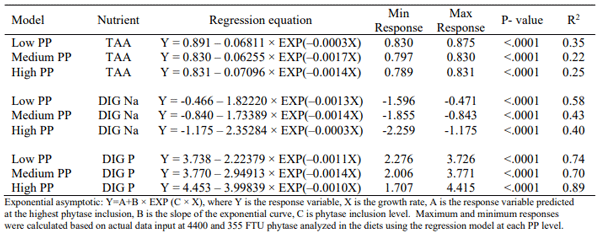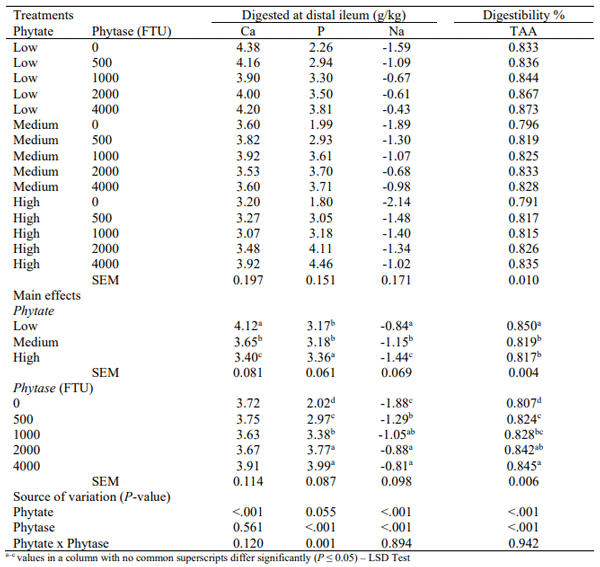I. INTRODUCTION
Phytic acid salts or phytate constitutes up to 70 % of the phosphorous (P) stored in cereal grains and oilseed meals and this P is poorly utilized by poultry due to limited endogenous phytase secretion (Ravindran, 1995). Therefore, exogenous phytase is routinely used in poultry feed worldwide to address the issue of optimizing P utilization and mitigating the negative impact of dietary phytate on bioavailability of other nutrients i.e. minerals and AA (Selle et al., 2000). Phytate, a negatively charged molecule, can electrostatically bind up other cations and positively charged nutrients such as proteins rendering them unavailable for further digestion and absorption (Selle and Ravindran, 2007). Although phytate exerts its negative effect over a wide pH range, its anti-nutritional effect is exacerbated as the pH of the gastrointestinal tract increases post-gizzard (Selle and Ravindran, 2007). Higher pH in the small intestine in the presence of phytate may precipitate negatively charged proteins via tertiary complexes with cations, forming a bridge between the two molecules. Such complexes are highly insoluble and more resistant to hydrolysis by proteases reducing the availability of both proteins and minerals (Kies et al., 2006). Thus, new generation microbial phytases have been developed to act more rapidly and completely to hydrolyze phytate, particularly in the upper digestive tract to avoid formation of phytate-mineral-protein complexes in the small intestine.
The current research trial was performed to compare the responses of incremental inclusion of a novel microbial phytase to different dietary phytate concentrations, measuring distal ileal digestibility of P, Ca, Na and AA as response criteria.
II. MATERIALS AND METHODS
The study procedures were reviewed and approved by the University of Sydney Animal Ethics Committee. A total of 1800 off-sex male chicks (Ross 308) were obtained from a local hatchery (Aviagen, Goulburn, NSW, Australia). Upon arrival, birds were group weighed and distributed to 90 battery cages with 6 replicate cages of 20 birds per treatment. A total of 15 dietary treatments were generated by factorially arranging 3 concentrations of dietary phytate (2.45, 2.95 or 3.45 g/kg) and 5 dietary inclusion levels of a novel consensus bacterial 6-phytase variant (PhyG), 0, 500, 1000, 2000 or 4000 FTU/kg. The starter and grower basal diets were formulated to contain 2.77 and 2.25 g/kg AvP and 7.6 and 6.4 g/kg Ca, respectively.
At 21 days post-hatch, 6 birds per replicate cage were euthanised by an intravenous injection of sodium pentobarbitone. The small intestine was removed and digesta was gently expressed from the distal half of the ileum and pooled by cage, homogenised, and freeze dried to determine the apparent digestibility coefficients of Ca, P, Na and AA. The obtained digestibility coefficients and analyzed dietary Ca, P and Na content were used to calculate the distal ileal digestible content (g/kg) of the above minerals.
Data were subjected to statistical analysis using 2-way ANOVA, GLM procedure (JMP Pro 14.0, SAS Institute, Cary, NC) to assess the main effects of dietary phytate, phytase inclusion, and their interaction. Significant treatment effects were subjected to Least Significant Differences tests for pairwise comparisons (P < 0.05). Applying exponential models, minimum and maximum responses to phytase inclusion were determined for each phytate level.
III. RESULTS
The effects of dietary treatments on ileal digestible Ca, P and Na (g/kg) and total AA ileal digestibility coefficients are presented in Table 1. Increasing dietary phytate decreased (P < 0.001) ileal digestibility of all AA (data not presented), Ca and Na. Regardless of phytate levels, phytase inclusion improved (P < 0.001) the digestibility of Na and all the AA tested, except methionine but had no effect (P > 0.05) on Ca digestibility. Ileal digestible P improved (P < 0.001) with increasing phytase inclusion. The improvement in digestible P associated with increasing phytase inclusion was more pronounced in high phytate diets resulting in a phytate level × phytase inclusion interaction (P < 0.001).
At the highest inclusion of 4000 FTU/kg phytase dietary ileal digestibility coefficient of total AA, using exponential models improved by 5.40, 4.14 and 5.32 % in low, medium and high PP diets, respectively (Table 2).
Table 1 - Total amino acids digestibility coefficient (TAA), dietary Ca, P and Na digested at distal ileum (g/kg) in response to dietary treatments
The predicted increase in Na digestibility in response to the highest dose of phytase was 70.5, 55.3, and 48.0 % in low, medium and high PP diets, respectively. The exponential models predicted an improvement of 63.7 % in digestible P at low PP, which increased to 88.0 % at medium PP and over 158 % at high PP content of the diets.
IV. DISCUSSION AND CONCLUSION
The improvement in AA digestibility was remarkably consistent at different phytate levels, averaging around 5.0 %. Similarly, in a systematic review Cowieson et al. (2017) reported a mean response of 4.0 % uplift in AA digestibility with phytase supplementation. The authors suggested that the pattern of response across all AA indicates that much of the beneficial effect stems from a reduction in the loss of endogenous protein from the intestine. Phytate has been shown to increase nutrients endogenous losses by interacting with endogenous enzymes or gastrointestinal mucin, increasing the excretion of endogenous AA and minerals (Cowieson et al., 2004).
Table 2 - Exponential models fit to predict coefficient of digestibility (%) of total amino acids (TAA), digestible (DIG) Na and P (g/kg) at distal ileum

The formation of indigestible protein-phytate complexes may lead to hypersecretion of both pepsin and hydrochloric acid, as a compensatory mechanism to rectify protein digestion. In response and as a protective measure to buffer intestine pH, pancreatic secretion of Na bicarbonate and gut mucous production increases, resulting in further endogenous loss of Na and the AA present in mucin. Furthermore, Na recovery due to phytase supplementation may promote Na+-dependent transporters activity and thereby increase the intestinal uptake of both glucose and AA. The results observed on ileal P digestibility suggest that at high dietary PP a higher phytase inclusion (> 2000 FTU/kg) is required to maximize P utilization by increasing phytate hydrolyzation. However, aligning P digestibility with Na and AA, as phytase doses are elevated beyond 2000 FTU suggests that whilst P continues to be liberated, from PP, this may not be the case and/or to the same extent for other nutrients, particularly AA. Further analysis of phytate destruction in the proximal gastrointestinal tract and small intestine should provide a clearer insight into the possible mechanisms through which phytase has improved AA, Na and P digestibility.
ACKNOWLEDGEMENTS: The authors would like to thank DuPont Animal Nutrition for financially supporting this research trial.
Presented at the 32th Annual Australian Poultry Science Symposium 2021. For information on the next edition, click here. 
















_1.jpg&w=3840&q=75)